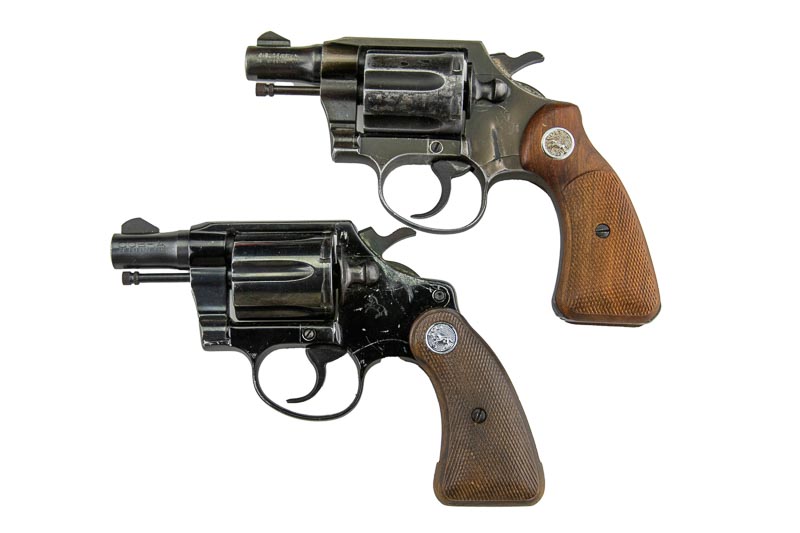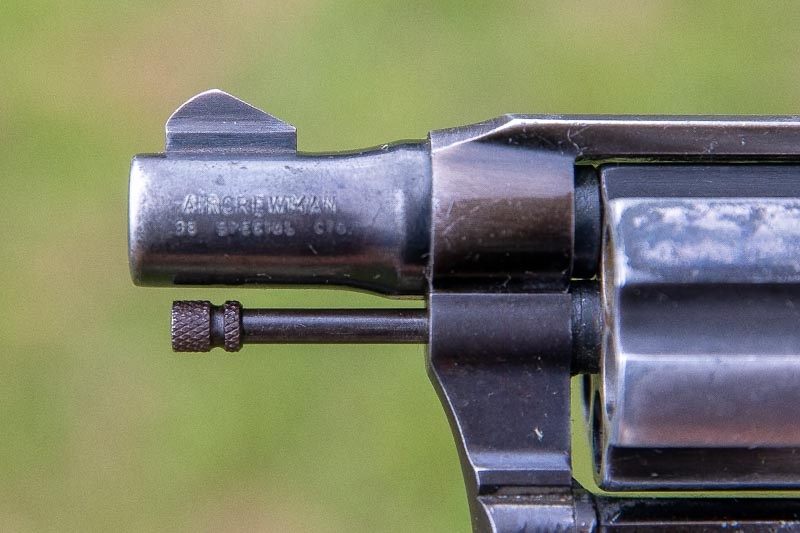Colt once made a ground-breaking super-light .38 Special revolver. 1,189 of them to be exact. They refused to sell them to the public, and almost all of them were ultimately destroyed. Here’s the story.
The Colt Aircrewman

After World War II, the Atomic Age blossomed in modernity in many ways. In the gun world, Colt became the first to introduce aluminum frame handguns: 1950 saw the Colt Commander semiautomatic developed originally for the military hit gun shop shelves to recoup their research costs after the US Government decided to stay with the all-steel 1911A1 .45 as the standard military sidearm. Contemporaneously, they built their Detective Special snub-nose .38 revolver with a lightweight aluminum frame and dubbed it the Cobra: it became an instant sales success among private citizens and cops alike for concealed carry.


And it caught the attention of the US Air Force. They put out bids for ultra-light six-shot .38 Special snubbies with the cylinders as well as the frames made of the lightweight metal. Colt beat their arch-rival Smith & Wesson to that particular bid list by two or three years. The aluminum-cylindered Cobra was called the Aircrewman. S&W’s Aircrewman of 1953 would be marked M13, USAF’s designation for the platform, a K-frame six-shooter. USAF apparently liked the Smith better and ordered more of them and Aircrewman revolvers were manufactured until 1957, all with those aluminum cylinders. Because aluminum wasn’t as strong as steel, the Air Force specified a light load: 130 grain full metal jacket round nose .38 Special in the mid-700 foot-second velocity range.
Rationale
Half a decade before, America’s WWII pilots had carried all-steel S&W Victory Model .38 Special revolvers and heavier 1911 .45 autos. Why was lightening the load so important? The best video I’m aware of on the Colt Aircrewman was done by Ian McCollum on his excellent Forgotten Weapons YouTube site. He postulates that the concern focused on pilots and other aircrew personnel who had to eject at high speed from crippled aircraft. Any metal object attached to their bodies could cause injuries flapping against them under those circumstances, hence the focus on the lightest possible gear.
Features

The Aircrewman was the first Colt revolver to have wooden stocks that went all the way up to the horn at the top of the rear grip-strap of the frame. This appears to have been copied from the Smith & Wesson Magna style which debuted in 1935 on S&W’s original .357 Magnum. Widening this surface with extended wood distributed the impact of recoil into the web of the hand; as with that S&W .357, the ultra-light USAF revolver even in .38 Special could be expected to have nasty recoil. In the chapter on the Aircrewman in his authoritative text “Colt’s Double Action Revolvers: the Post-War Years” expert Gurney Brown states that this feature was specifically requested by the Air Force. Doubtless, they had done some homework before writing their specs.
My own Colt Aircrewman, and every one I’ve seen, has the longer ejector rod of later D-frame Colt snub-noses, and not the stubby one that was seen on the early 1950 commercial Colt Cobras, such as the infamous specimen used by Jack Ruby to shoot Lee Harvey Oswald. This leads me to wonder whether the savvy Air Force armorers expressly requested that for the Aircrewman guns, and Colt wisely incorporated it in the later production of two-inch barrel D-frame revolvers.
The Aircrewman’s uniquely styled wooden stocks produced for the Air Force also had their own USAF logo medallion instead of the manufacturer’s trademark rampant colt.
The USAF guns were stamped “PROPERTY OF U.S. AIR FORCE” on the backstrap of the grip, and on the butt bore a USAF property number. The abbreviation for “number” was sometimes an all-caps NO and sometimes had just the N capitalized. Colt’s actual serial numbers were found on the frame inside the cylinder yoke and ranged from 2901-LW to 7775-LW, because they were produced sporadically as ordered by USAF and numbered in the regular SN range for the general production guns of this type. While S&W’s Aircrewman revolvers are marked M13, the USAF designation, the Colt versions are not.
The Achilles Heel
Colt specified the Cobra’s weight as 15.5 ounces unloaded with its aluminum frame and steel cylinder and barrel, compared to the otherwise identical steel frame Detective Special’s 21 ounces. They spec’d the Colt Aircrewman at 11 ounces with its aluminum cylinder. (Interestingly, my own specimen went a little over 12 ounces on a calibrated scale.) The aluminum cylinder, which the factory called “Coltalloy,” was the key to the extreme weight reduction.

It was also the weak spot in the design. With a conventional .38 Special chamber, it could accept any round in that caliber. This included the .38/44 S&W Special cartridge introduced in 1930, an Elmer Keith-like hot load which inspired the even hotter .357 Magnum round a decade earlier. It was feared that if a .38-44 or a hot handload got into that super-light cylinder, it could turn the revolver into high-velocity aluminum shards.
You’ve heard the phrase “the juice ain’t worth the squeeze”? Well, in this case, the lightened juice wasn’t worth the injury risk and liability squeeze. As a result, by 1959, all the Aircrewman guns from both Colt and Smith & Wesson were determined too dangerous to use. They were withdrawn from service and sent to the crusher to be destroyed. While it is believed that some few of the aluminum cylindered Aircrewman might have gone somewhere other than to the Air Force, the gun was never cataloged nor offered for sale to the general public by Colt for exactly this reason.
How rare is the Colt Aircrewman revolver?
Colt scholars agree that some 1,189 Aircrewman revolvers were made by the company. The vast majority went into the crusher. Some of the crushed ones show up at auctions as symbols of what happens when guns are “turned in.”
Gurney Brown writes, “Of the 1,189 guns ordered by the Pentagon, it is estimated that fewer than two dozen (50 according to some sources) survived destruction.” His book lists 21 known to exist, one with a cracked frame. The last Colt Aircrewman I saw auctioned sold for just under $10,000. Gurney Brown comments, “It is almost certain that Colt produced more examples of this model than the Air Force contracted for.” This may explain why my own Aircrewman has Colt medallions instead of USAF on its stocks.
We can understand why Colt never put this gun into mainstream. My own specimen, seen in the accompanying photos, is not for sale.



